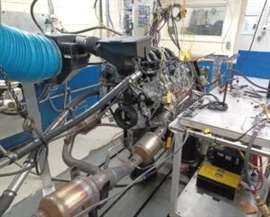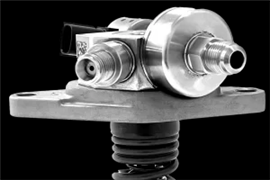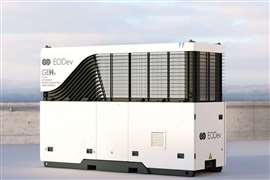Research program reveals viability of LPG direct injection in medium-duty engines
22 February 2024
Funded by PERC and conducted by Katech Engineering, the project used software as well as specially designed hardware from Stanadyne to help overcome vapor lock.
The results of a recent research program show that liquid propane gas (LPG) direct injection could be a viable option for medium-duty engines.
Performance engine and vehicle builder Katech Engineering recently completed the research program, which was funded by the Propane Education & Research Council (PERC). According to program participant Stanadyne, the focus was on the development and testing of a direct injection fuel system using new hardware and software inhibitor technologies to remove vapor lock barriers unique to propane.
 The General Motors L8T 6.6L GDI test engine was updated with the Stanadyne components and operated on LPG direct injection. (Photo: Stanadyne)
The General Motors L8T 6.6L GDI test engine was updated with the Stanadyne components and operated on LPG direct injection. (Photo: Stanadyne)
According to the final project report, high vapor pressure and extreme heat transfer conditions, such as hot-soak and hot-idle conditions, can cause LPG to vaporize inside the high-pressure fuel pump. The result is engine stall, failure to maintain power and torque and even catastrophic pump failure.
The research team worked directly with Stanadyne to design LPG-specific fuel pumps and injectors. Stanadyne said the test engine — a General Motors L8T 6.6L GDI engine, according to the final research report — was updated with the Stanadyne components and operated on LPG direct injection. Power Progress reported in September 2023 that Stanadyne’s new direct-injection fuel pump and injector system was coupled with Katech’s vapor lock technology to deliver propane autogas at a constant 350-bar pressure while avoiding the potential for vapor lock.
The project results showed the new hardware and software technologies made for stable engine operation during hot-start, cold-start, hot-soak and hot-idle conditions, Stanadyne said. It also showed robust performance over a 250-hour durability test using a customized duty cycle.
“Overall, the proposed fuel system with in-house-developed vapor lock inhibitor hardware and software addressed the design limitations faced by other LPG direct injection applications,” said Eric Suits, principal investigator and lead R&D/motorsport engineer Eric Suits. “The research results prove the efficacy of liquid propane as a fuel for direct injection while addressing the previous design limitations.”
The project also showed the fuel system to be a practical one.
“Limited modifications were made to the test engine,” said Stanadyne Chief Engineer Srinu Gunturu. “Along with Stanadyne’s new LPG direct injection pump and injectors, the proposed technology shows a high level of feasibility for cost-effectiveness and widespread production and commercialization.”
Using LPG — particularly renewable propane produced as a byproduct of renewable diesel — has implications for cleaner propulsion, especially for vehicle markets that are difficult to electrify, such as medium- and heavy-duty vehicles, Stanadyne said. These include reductions in carbon dioxide (CO2) emissions and almost no nitrogen oxide (NOx) emissions compared to traditional diesel fuel.
STAY CONNECTED



Receive the information you need when you need it through our world-leading magazines, newsletters and daily briefings.
CONNECT WITH THE TEAM











